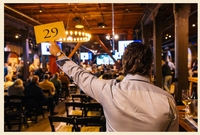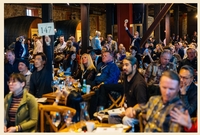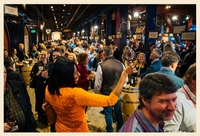And maybe it is. Then again, maybe not.
 Toward the end of February, I was in Napa Valley to work on a few article assignments and to attend the Premiere Napa Valley Auction and the three days of winery visits, barrels tastings and big dinners that led up to it. While there, I chatted with Blake at several events, including at Saturday’s auction, which was attended by about 1,000 people in the wine trade, most ready to wave their paddles while about half the Valley’s vintners and a score of media were there to bear witness.
Toward the end of February, I was in Napa Valley to work on a few article assignments and to attend the Premiere Napa Valley Auction and the three days of winery visits, barrels tastings and big dinners that led up to it. While there, I chatted with Blake at several events, including at Saturday’s auction, which was attended by about 1,000 people in the wine trade, most ready to wave their paddles while about half the Valley’s vintners and a score of media were there to bear witness.
Blake, of course, is an excellent writer and a fine companion on wine trips [and a Wine Review Online Columnist Emeritus—ed.]. But I think he might forgive me for noting that, when it comes to choosing subject matter, Blake is like a struck match looking for dry underbrush. The auction itself was full of excitement – the blazing paddles of rapid-fire bidding, egged on by Sotheby’s bid-inducing auctioneer with a Mick Jagger-like strut as well as beaucoup Valley people, hooting and hollering as prices for 167 lots of one-of-a-kind wines often reached five figures.
W. Blake was having none of it.
On Monday morning, he lead his report with, “The slowdown in wine sales has finally come to Napa Valley, in shocking and dramatic fashion,” adding that, “This year’s average bottle price of $195 was down 32 percent from last year. I can say confidently it’s the lowest average bottle price in a decade.”
 True, that appraisal is certainly consistent with, though more cataclysmic than, the modest drop in overall U.S wine sales in 2023. But the question is, as it always is, what are we to deduce from those observations?
True, that appraisal is certainly consistent with, though more cataclysmic than, the modest drop in overall U.S wine sales in 2023. But the question is, as it always is, what are we to deduce from those observations?
The mood I sensed at both auction events as well as in my one-on-one winery interviews with the folks at Cain, Dunn, Opus One, Outpost, Harlan, Signorello, Trefethen, Hyde de Villaine, Pym-Rae and Cathiard was very upbeat. That was true even though two of those wineries – Cain and Signorello – are in the midst of replanting and rebuilding after being wiped out by wildfires.
I’ve often thought that too much emphasis in American business has been put on volume growth at any cost and not enough attention paid to quality of earnings – profit margins. So, I wonder if the dip in auction prices doesn’t simply reflect a needed market correction, one similar to those Burgundy and Bordeaux periodically go through? However sad it is, marginal players will drop out while people who can balance quality and savvy marketing with their cost of goods will prosper.
Moreover, no matter the reliability of the formulae Blake is using, I’m not sure how reliable the input can be when, with each year’s auction, there are changes in the participating producers, the types of wines they are offering, the lot sizes, the lot formats, the individual auctioneers whipping up the bidding and even the mood and makeup of the bidders. Those of us in the wine and spirits industry over 50 may remember that whiskey sales, particularly Bourbons and Tennessee whiskies, were so abysmal during the 1990s that George Dickel, among others, even stopped production and mothballed its main distillery. (My old high school buddy, Jennings David Backus, was head distiller at the time and was given that task.)
 So, do we practice augury by looking into Blake’s Gray Sky or in the sea of blazing paddles of this year’s bidders? Even if American wine sales continue to decline slightly over the next few years, I’m not ready to look through my wine glass darkly, not just yet.
So, do we practice augury by looking into Blake’s Gray Sky or in the sea of blazing paddles of this year’s bidders? Even if American wine sales continue to decline slightly over the next few years, I’m not ready to look through my wine glass darkly, not just yet.
Birthing Partners: For Napa Valley wines, having an official consulting winemaker has become a required status symbol, one on the same level as having your own special trainer. Personally, I like to think of these wine whisperers as a winery’s “birthing partners,” especially called upon as veraison signals and harvest delivers. Looking through this year’s auction catalogue, four names kept popping up as winemakers or consultants.
By my unofficial count, Philippe Melka helped give birth to the most wines, having seems, having edged out Thomas Rivers Brown by a corkscrew. There were six citations for Melka to five for TRB (ancient readers of the New Republic will smile). Almost as ubiquitous were Julien Fayard and Jean Hoefliger. Michel Rolland trailed with two. Either being French by birth or having three official names seems to help when you’re looking for consulting gigs.
New AVAs: So far, Napa Valley has 16 candles – its “nested AVAs,” though they are never allowed to outshine Napa Valley’s torch on wine labels. There soon may be two more flames, according to Napa Valley Vintners’ Rex Stults. One newbie has the working designation of “Crystal Springs,” lying below the fog level that officially marks the beginning of Howell Mountain AVA and next door to Calistoga AVA. The other one is tentatively being called “Suscol” and is SW of Coombsville in the area of Napa’s airport and American Canyon.
Harlan County, USA: I had a lovely visit one afternoon to Harlan Estate – a beautiful sylvan hillside setting that would make the château-dwelling Bordelais envious – and enjoyed its very highly rated wines. Bill Harlan, and now his son, Will, have to be admired for the footprint they have made, and continue to make, in Napa County in terms of the quality of their winemaking, hospitality and real estate ventures.
Following my visit to the Harlan Estate, which celebrates its 40th year in 2024, I went back to my room at the Southbridge hotel in St. Helena, then walked a block away to an evening auction party in the Charter Oak restaurant. The following night, I ate at Tra Vigne pizza parlor in the same building as my hotel. All three are owned in part or totally by the Harlans, and Bill Harlan was once a partner in Merryvale Winery, next door. Not to mention the Harlans’ involvement with Meadowood resort, the Napa Valley Reserve, and etc., etc.
The Wildfire Vintage: California’s wine country has historically experienced wildfires, none worse than those of 2017 and again in 2020, especially the Glass Fire in that latter year that leaped the valley floor from the eastern Vaca Mountains to the western Mayacamas range. Several producers, including Cain, Newton and Burgess, lost wineries and significant parts of their vineyards that fall.
Still other wineries found that while they were spared the flames, they couldn’t escape the smoke. Tom Gamble, owner of Gamble Family Vineyards in Oakville, told me, “We left 2020 hanging because of the smoke,” he says. “I experimented with trying to make a vintage after the 2017 vintage, but I didn’t like it.” Others, who were able to pick part of 2020 early, decided on a reduced vintage. “We lost about 70% of the 2020,” said Wesley Steffens of Vineyard 7&8 on Spring Mountain.
While visiting Opus One, I was told the decision was made not to have a 2020 vintage, but that, nevertheless, a portion of the estate vineyard was harvested and made into wine “for the library.” I asked if, in a year or three, the proprietors might taste the 2020, find it to be of superior quality with aging potential and quietly decide to have a 2020 Opus One library release after all?
I received a broad smile in reply. As always, a sign can be interpreted many ways.
